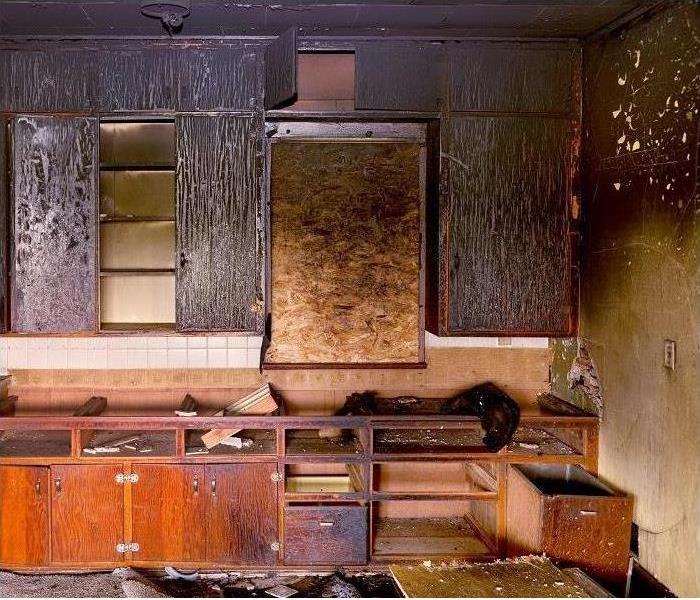What Obstacles Exist with Cleaning Fire-Damaged Finished Wood Surfaces in Everett?
4/28/2022 (Permalink)
With Wood Flooring, Cabinets, and Other Elements in Everett Homes, Fire Damage Cleaning Can be an Intricate Process to Avoid Tear-out and Reconstruction.
When house fires occur in Everett communities, you can feel overwhelmed by the initial appearance of the property. The burning of fuels like wood can create soot and smoke residues that coat surfaces to appear like irreparable damages and total losses. In truth, there are often many ways to clean and restore these coated surfaces when it is cost-effective and beneficial to do so.
Fire restoration in Everett homes can be complicated by elements like finished wood, despite its advantages of being less porous than untreated options. A finish on the surface can protect these elements from quickly absorbing secondary concerns in the house after a fire, such as pooling water from extinguishment. This lower permeance also reduces how damaged these elements can become when directly exposed to smoke and soot residues coming to rest on the surface. The most commonly affected finished wood fixtures and materials within your house include:
- Cabinets
- Flooring
- Wall Materials
- Furniture
What Type of Finish?
Just having finished wood surfaces might seem like enough information for restoration professionals like our SERVPRO team. However, there are often more answers needed to treat the affected materials and prevent tear-out and rebuilding. The types of finish vary considerably between furniture and fixtures of the property but often include several potential options:
- Varnish
- Polyurethane
- Shellac
- Paint
- Lacquer
Each of these finishes can react differently over varying exposure times to direct fire damage or lingering soot and smoke residues. Cleaning these elements is an essential component of property loss recovery, however, and should begin as soon as mitigation efforts get underway in the house.
What Is the Common Method of Cleaning Residues?
Based on the evaluation of the damages conducted by our competent project manager after the property is cleared to enter by first responders, we can determine the best approach for removing soot residues from finished wood. Wet and dry smoke concerns can often clean up differently than more stubborn grease-based protein residues that might impact finished wood cabinets in a kitchen area. Typically, the cleaning of light or moderately damaged wood surfaces involves:
- Wet Cleaning – The application of water-based solvents, detergents, and wet sponging in damaged areas can often be a practical choice for residue removal.
- Agitation – Light agitation like scrubbing on finished wood can be beneficial to ensure that any grain markings get cleaned. We can remove loose soils from the surface before wet cleaning with dry vacuuming.
- Soft Cleansers – General surface cleaners are often all that is necessary for removing soils from finished wood unless the concentration of these residues is severe.
What Steps Are Needed for Heavier Smoke Damages?
Ultimately, there are often always surfaces that become heavily impacted by circulating soot and smoke particles. Thick and challenging residues require focused attention and products to resolve. During the mitigation phases, where other surface cleaning actions are taking place, we can work on the multiple-phase cleaning of heavily soiled structural elements and contents. Individual items can benefit from restoration at our nearby SERVPRO facility under our experienced cleaning technicians' eye, while installed materials require on-site solutions, such as:
- Stronger Agitation – Beyond practices like removing heaped soils with vacuuming, more abrasive cleaning techniques might be necessary with steel wool to achieve the desired level of soil removal.
- Potent Cleaners – Wood créme cleaners can be a beneficial choice in products for heavier smoke damage.
- Stripping – Completely removing the finish on wood surfaces can often be an aggressive technique for removing smoke damage when it is cost-efficient.
- Controlled Demolition – In the most extreme cases, when even more direct cleaning methods are not sufficient, our contractors can remove the damaged material or fixture altogether and replace them later.
Does SERVPRO Do Reconstruction?
When controlled demolition occurs or structural compromise exists from the fire itself, our professionals and contractors can both work to achieve efficient results in repairing and restoring the property. Reconstruction is often a vital element in making fire losses “Like it never even happened.” Building trade professionals on our roster can complete initial temporary construction solutions based on the immediate needs of the property and full-scale build back upon mitigation phases completing.
Fire losses can feel overwhelming for homeowners, especially when you are unsure of what to expect with soot-covered surfaces and finished wood furniture. Our SERVPRO of North Everett / Lake Stevens / Monroe team can help with a fast response 24/7 by calling (360) 243-8313.






 24/7 Emergency Service
24/7 Emergency Service
